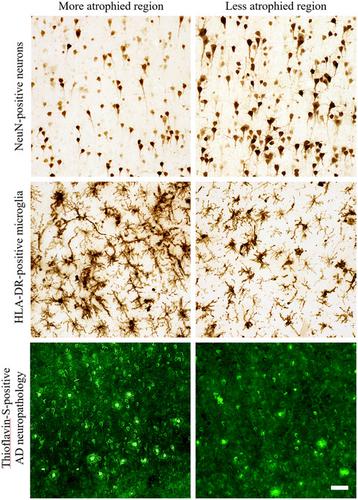当前位置:
X-MOL 学术
›
Brain Pathol.
›
论文详情
Our official English website, www.x-mol.net, welcomes your
feedback! (Note: you will need to create a separate account there.)
Accumulation of neurofibrillary tangles and activated microglia is associated with lower neuron densities in the aphasic variant of Alzheimer’s disease
Brain Pathology ( IF 5.8 ) Pub Date : 2020-10-03 , DOI: 10.1111/bpa.12902 Daniel T Ohm 1 , Angela J Fought 2 , Adam Martersteck 1 , Christina Coventry 1 , Jaiashre Sridhar 1 , Tamar Gefen 1, 3 , Sandra Weintraub 1, 3 , Eileen Bigio 1, 4 , M-Marsel Mesulam 1, 5 , Emily Rogalski 1, 3 , Changiz Geula 1
Brain Pathology ( IF 5.8 ) Pub Date : 2020-10-03 , DOI: 10.1111/bpa.12902 Daniel T Ohm 1 , Angela J Fought 2 , Adam Martersteck 1 , Christina Coventry 1 , Jaiashre Sridhar 1 , Tamar Gefen 1, 3 , Sandra Weintraub 1, 3 , Eileen Bigio 1, 4 , M-Marsel Mesulam 1, 5 , Emily Rogalski 1, 3 , Changiz Geula 1
Affiliation

|
The neurofibrillary tangles (NFT) and amyloid‐ß plaques (AP) that comprise Alzheimer’s disease (AD) neuropathology are associated with neurodegeneration and microglial activation. Activated microglia exist on a dynamic spectrum of morphologic subtypes that include resting, surveillant microglia capable of converting to activated, hypertrophic microglia closely linked to neuroinflammatory processes and AD neuropathology in amnestic AD. However, quantitative analyses of microglial subtypes and neurons are lacking in non‐amnestic clinical AD variants, including primary progressive aphasia (PPA‐AD). PPA‐AD is a language disorder characterized by cortical atrophy and NFT densities concentrated to the language‐dominant hemisphere. Here, a stereologic investigation of five PPA‐AD participants determined the densities and distributions of neurons and microglial subtypes to examine how cellular changes relate to AD neuropathology and may contribute to cortical atrophy. Adjacent series of sections were immunostained for neurons (NeuN) and microglia (HLA‐DR) from bilateral language and non‐language regions where in vivo cortical atrophy and Thioflavin‐S‐positive APs and NFTs were previously quantified. NeuN‐positive neurons and morphologic subtypes of HLA‐DR‐positive microglia (i.e., resting [ramified] microglia and activated [hypertrophic] microglia) were quantified using unbiased stereology. Relationships between neurons, microglia, AD neuropathology, and cortical atrophy were determined using linear mixed models. NFT densities were positively associated with hypertrophic microglia densities (P < 0.01) and inversely related to neuron densities (P = 0.01). Hypertrophic microglia densities were inversely related to densities of neurons (P < 0.01) and ramified microglia (P < 0.01). Ramified microglia densities were positively associated with neuron densities (P = 0.02) and inversely related to cortical atrophy (P = 0.03). Our findings provide converging evidence of divergent roles for microglial subtypes in patterns of neurodegeneration, which includes hypertrophic microglia likely driving a neuroinflammatory response more sensitive to NFTs than APs in PPA‐AD. Moreover, the accumulation of both NFTs and activated hypertrophic microglia in association with low neuron densities suggest they may collectively contribute to focal neurodegeneration characteristic of PPA‐AD.
中文翻译:

神经原纤维缠结和激活的小胶质细胞的积累与阿尔茨海默病失语症患者的神经元密度较低有关
构成阿尔茨海默病 (AD) 神经病理学的神经原纤维缠结 (NFT) 和淀粉样蛋白斑 (AP) 与神经退行性变和小胶质细胞激活有关。活化的小胶质细胞存在于一系列动态的形态学亚型中,其中包括能够转化为活化的肥大性小胶质细胞的静止监视性小胶质细胞,这些小胶质细胞与遗忘性 AD 中的神经炎症过程和 AD 神经病理学密切相关。然而,对于非遗忘性临床 AD 变异,包括原发性进行性失语症 (PPA-AD),缺乏对小胶质细胞亚型和神经元的定量分析。 PPA-AD 是一种语言障碍,其特征是皮质萎缩和 NFT 密度集中于语言优势半球。在这里,对五名 PPA-AD 参与者进行的体视学研究确定了神经元和小胶质细胞亚型的密度和分布,以研究细胞变化如何与 AD 神经病理学相关以及可能导致皮质萎缩。对相邻系列切片进行免疫染色,对来自双侧语言和非语言区域的神经元 (NeuN) 和小胶质细胞 (HLA-DR) 进行免疫染色,其中先前对体内皮质萎缩和硫磺素-S 阳性 AP 和 NFT 进行了定量。使用无偏见的体视学对 NeuN 阳性神经元和 HLA-DR 阳性小胶质细胞的形态亚型(即静息[分支]小胶质细胞和激活[肥大]小胶质细胞)进行量化。使用线性混合模型确定神经元、小胶质细胞、AD 神经病理学和皮质萎缩之间的关系。 NFT 密度与肥大性小胶质细胞密度呈正相关 ( P < 0.01),与神经元密度呈负相关 ( P = 0.01)。 肥大的小胶质细胞密度与神经元( P %3C 0.01)和分枝小胶质细胞( P %3C 0.01)的密度呈负相关。分支小胶质细胞密度与神经元密度呈正相关( P = 0.02),与皮质萎缩呈负相关( P = 0.03)。我们的研究结果提供了小胶质细胞亚型在神经变性模式中不同作用的证据,其中包括肥大的小胶质细胞可能驱动神经炎症反应,在 PPA-AD 中对 NFT 比 AP 更敏感。此外,NFT 和活化的肥大性小胶质细胞的积累与低神经元密度相关,表明它们可能共同导致 PPA-AD 的局灶性神经退行性变特征。
更新日期:2020-10-03
中文翻译:

神经原纤维缠结和激活的小胶质细胞的积累与阿尔茨海默病失语症患者的神经元密度较低有关
构成阿尔茨海默病 (AD) 神经病理学的神经原纤维缠结 (NFT) 和淀粉样蛋白斑 (AP) 与神经退行性变和小胶质细胞激活有关。活化的小胶质细胞存在于一系列动态的形态学亚型中,其中包括能够转化为活化的肥大性小胶质细胞的静止监视性小胶质细胞,这些小胶质细胞与遗忘性 AD 中的神经炎症过程和 AD 神经病理学密切相关。然而,对于非遗忘性临床 AD 变异,包括原发性进行性失语症 (PPA-AD),缺乏对小胶质细胞亚型和神经元的定量分析。 PPA-AD 是一种语言障碍,其特征是皮质萎缩和 NFT 密度集中于语言优势半球。在这里,对五名 PPA-AD 参与者进行的体视学研究确定了神经元和小胶质细胞亚型的密度和分布,以研究细胞变化如何与 AD 神经病理学相关以及可能导致皮质萎缩。对相邻系列切片进行免疫染色,对来自双侧语言和非语言区域的神经元 (NeuN) 和小胶质细胞 (HLA-DR) 进行免疫染色,其中先前对体内皮质萎缩和硫磺素-S 阳性 AP 和 NFT 进行了定量。使用无偏见的体视学对 NeuN 阳性神经元和 HLA-DR 阳性小胶质细胞的形态亚型(即静息[分支]小胶质细胞和激活[肥大]小胶质细胞)进行量化。使用线性混合模型确定神经元、小胶质细胞、AD 神经病理学和皮质萎缩之间的关系。 NFT 密度与肥大性小胶质细胞密度呈正相关 ( P < 0.01),与神经元密度呈负相关 ( P = 0.01)。 肥大的小胶质细胞密度与神经元( P %3C 0.01)和分枝小胶质细胞( P %3C 0.01)的密度呈负相关。分支小胶质细胞密度与神经元密度呈正相关( P = 0.02),与皮质萎缩呈负相关( P = 0.03)。我们的研究结果提供了小胶质细胞亚型在神经变性模式中不同作用的证据,其中包括肥大的小胶质细胞可能驱动神经炎症反应,在 PPA-AD 中对 NFT 比 AP 更敏感。此外,NFT 和活化的肥大性小胶质细胞的积累与低神经元密度相关,表明它们可能共同导致 PPA-AD 的局灶性神经退行性变特征。











































 京公网安备 11010802027423号
京公网安备 11010802027423号